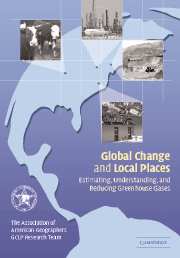Book contents
- Frontmatter
- Contents
- List of contributors
- Foreword
- Preface
- Acknowledgments
- Part One Global change and local places
- 1 A grand query: how scale matters in global change research
- 2 The research strategy: linking the local to the global
- Part Two Learning from localities
- Part Three Beyond Kyoto I: greenhouse gas reduction in local places
- Part Four Beyond Kyoto II: greenhouse gas reduction potentials and strategies
- Index
- References
1 - A grand query: how scale matters in global change research
Published online by Cambridge University Press: 31 July 2009
- Frontmatter
- Contents
- List of contributors
- Foreword
- Preface
- Acknowledgments
- Part One Global change and local places
- 1 A grand query: how scale matters in global change research
- 2 The research strategy: linking the local to the global
- Part Two Learning from localities
- Part Three Beyond Kyoto I: greenhouse gas reduction in local places
- Part Four Beyond Kyoto II: greenhouse gas reduction potentials and strategies
- Index
- References
Summary
Grand queries are fundamental questions that transcend the form and substance of individual sciences; they often appear simultaneously in many disciplines. A recurring grand query focuses on scale: how to relate universals to particulars, wholes to parts, macro-processes to micro-behavior, and global to local. Biologists ponder the linkages among molecules, cells, and organisms; ecologists among patches, ecosystems, and biomes; economists among firms, industries, and economies; and geographers among places, regions, and Earth (Rediscovering Geography Committee 1997: 95–102; Alexander et al. 1987; Holling 1992; Levin 1992; Meyer and Turner 1998; Meyer et al. 1992; Turner, M. G. et al. 1993). Scientists in many disciplines worry about non-linear processes and complexity: whether understanding its components can explain the properties of a large system (Gallagher and Appenzeller 1999). Or the reverse, as in the case of global climate change: can the rapidly accruing understanding of the large Earth system inform the ways people and biota in particular places alter climate and in turn are affected by climate change?
This chapter places the Global Change and Local Places project in the context of a grand query: how scale matters in global climate change. It examines the scale at which global change and responses to it take place, and how well the current scales of science and policy match the current scales at which changes are engendered.
- Type
- Chapter
- Information
- Global Change and Local PlacesEstimating, Understanding, and Reducing Greenhouse Gases, pp. 3 - 26Publisher: Cambridge University PressPrint publication year: 2003
References
- 2
- Cited by

